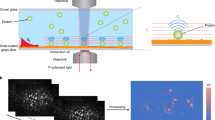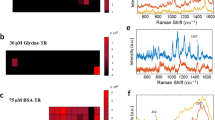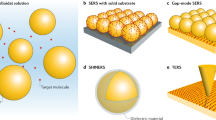Abstract
Measurement of enzyme activity and selectivity at in vivo concentrations is highly desirable in a range of fields including diagnostics, functional proteomics and directed evolution. Here we demonstrate how surface-enhanced resonance Raman scattering (SERRS), measured using silver nanoparticles, can be used to detect the activity of hydrolases at ultra-low levels. This approach was made possible by designing 'masked' enzyme substrates that are initially completely undetected by SERRS. Turnover of the substrate by the enzyme leads to the release of a surface targeting dye, and intense SERRS signals proportional to enzyme activity are generated. The method was used to rapidly screen the relative activities and enantioselectivities of fourteen enzymes including examples of lipases, esterases and proteases. In the current format the sensitivity of the technique is sufficient to detect 500 enzyme molecules, which offers the potential to detect multiple enzyme activities simultaneously and at levels found within single cells.
This is a preview of subscription content, access via your institution
Access options
Subscribe to this journal
Receive 12 print issues and online access
$209.00 per year
only $17.42 per issue
Buy this article
- Purchase on Springer Link
- Instant access to full article PDF
Prices may be subject to local taxes which are calculated during checkout





Similar content being viewed by others
References
Reetz, M.T., Zonta, A., Schimossek, K., Liebeton, K. & Jaeger, K.E. Creation of enantioselective biocatalysts for organic chemistry by in vitro evolution. Angew. Chem. Int. Ed. Engl. 36, 2830–2832 (1997).
Baumann, M., Sturmer, R. & Bornscheuer, U.T. A high-throughput-screening method for the identification of active and enantioselective hydrolases. Angew. Chem. Int. Ed. Engl. 40, 4201–4204 (2001).
Reetz, M.T., Becker, M.H., Kuhling, K.M. & Holzwarth, A. Time-resolved IR-thermographic defection and screening of enantioselectivity in catalytic reactions. Angew. Chem. Int. Ed. Engl. 37, 2647–2650 (1998).
Reetz, M.T. et al. A GC-based method for high-throughput screening of enantio selective catalysts. Catal. Today 67, 389–396 (2001).
Guo, J.H., Wu, J.Y., Siuzdak, G. & Finn, M.G. Measurement of enantiomeric excess by kinetic resolution and mass spectrometry. Angew. Chem. Int. Ed. Engl. 38, 1755–1758 (1999).
Reetz, M.T., Becker, M.H., Klein, H.W. & Stockigt, D. A method for high-throughput screening of enantioselective catalysts. Angew. Chem. Int. Ed. Engl. 38, 1758–1761 (1999).
Reetz, M.T., Kuhling, K.M., Deege, A., Hinrichs, H. & Belder, D. Super-high-throughput screening of enantioselective catalysts by using capillary array electrophoresis. Angew. Chem. Int. Ed. Engl. 39, 3891–3893 (2000).
Janes, L.E., Kazlauskas, R.J. & Quick, E. A fast spectrophotometric method to measure the enantioselectivity of hydrolases. J. Org. Chem. 62, 4560–4561 (1997).
Janes, L.E., Lowendahl, A.C. & Kazlauskas, R.J. Quantitative screening of hydrolase libraries using pH indicators: identifying active and enantioselective hydrolases. Chem. Eur. J. 4, 2324–2331 (1998).
Moris-Varas, F. et al. Visualization of enzyme-catalyzed reactions using pH indicators: Rapid screening of hydrolase libraries and estimation of the enantioselectivity. Bioorg. Med. Chem. 7, 2183–2188 (1999).
Klein, G. & Reymond, J.L. Enantioselective fluorogenic assay of acetate hydrolysis for detecting lipase catalytic antibodies. Helv. Chim. Acta 82, 400–407 (1999).
Olsen, M.J. et al. Function-based isolation of novel enzymes from a large library. Nat. Biotechnol. 18, 1071–1074 (2000).
Stacy, A.M. & Vanduyne, R.P. Surface enhanced Raman and resonance Raman-spectroscopy in a non-aqueous electrochemical environment - Tris(2,2′- bipyridine) ruthenium(Ii) adsorbed on silver from acetonitrile. Chem. Phys. Lett. 102, 365–370 (1983).
Hildebrandt, P. & Stockburger, M. Surface-enhanced resonance Raman-spectroscopy of rhodamine-6g adsorbed on colloidal silver. J. Phys. Chem. 88, 5935–5944 (1984).
Munro, C.H., Smith, W.E., Garner, M., Clarkson, J. & White, P.C. Characterization of the surface of a citrate-reduced colloid optimized for use as a substrate for surface-enhanced resonance Raman-scattering. Langmuir 11, 3712–3720 (1995).
Rodger, C., Smith, W.E., Dent, G. & Edmondson, M. Surface-enhanced resonance-Raman scattering: in informative probe of surfaces. J. Chem. Soc., Dalton Trans. 5, 791–799 (1996).
Graham, D. et al. Selective detection of deoxyribonucleic acid at ultralow concentrations by SERRS. Anal. Chem. 69, 4703–4707 (1997).
Graham, D., Mallinder, B.J. & Smith, W.E. Surface-enhanced resonance Raman scattering as a novel method of DNA discrimination. Angew. Chem. Int. Ed. Engl. 39, 1061–1064 (2000).
Graham, D., Mallinder, B.J., Whitcombe, D. & Smith, W.E. Surface enhanced resonance Raman scattering (SERRS)—a first example of its use in multiplex genotyping. Chemphyschem 2, 746–748 (2001).
Graham, D., Mallinder, B.J., Whitcombe, D., Watson, N.D. & Smith, W.E. Simple multiplex genotyping by surface-enhanced resonance Raman scattering. Anal. Chem. 74, 1069–1074 (2002).
Graham, D. et al. Synthesis of novel monoazo benzotriazole dyes specifically for surface enhanced resonance Raman scattering. Chem. Commun. 11, 1187–1188 (1998).
McAnally, G. et al. SERRS dyes.—Part I. Synthesis of benzotriazole monoazo dyes as model analytes for surface enhanced resonance Raman scattering. Analyst 127, 838–841 (2002).
Katritzky, A.R. & Drewniak, M. The chemistry of benzotriazole.8. a novel 2-step procedure for the N-alkylation of amides. J. Chem. Soc. Perkin Trans. 1, 2339–2344 (1988).
Nie, S.M. & Emery, S.R. Probing single molecules and single nanoparticles by surface-enhanced Raman scattering. Science 275, 1102–1106 (1997).
Kneipp, K. et al. Single molecule detection using surface-enhanced Raman scattering (SERS). Phys. Rev. Lett. 78, 1667–1670 (1997).
Varadharaj, G., Hazell, K. & Reeve, C.D. An efficient preparative scale resolution of 3-phenylbutyric acid by lipase from Burkholderia cepacia (Chirazyme L1). Tetrahedron Asymmetry 9, 1191–1195 (1998).
Bai, C.L., Wang, C., Xie, X.S. & Wolynes, P.G. Single molecule physics and chemistry. Proc. Natl. Acad. Sci. USA 96, 11075–11076 (1999).
Lee, P.C. & Meisel, D. Adsorption and surface-enhanced Raman of dyes on silver and gold sols. J. Phys. Chem. 86, 3391–3395 (1982).
Yguerabide, J. & Yguerabide, E.E. Light-scattering submicroscopic particles as highly fluorescent analogs and their use as tracer labels in clinical and biological applications—II. Experimental characterization. Anal. Biochem. 262, 157–176 (1998).
Acknowledgements
The authors wish to thank the BBSRC for funding this work.
Author information
Authors and Affiliations
Corresponding authors
Ethics declarations
Competing interests
The authors declare no competing financial interests.
Supplementary information
Supplementary Fig. 1
Rate of colloid Aggregation (PDF 63 kb)
Supplementary Fig. 2
SERRS monitoring of complete reaction profile (PDF 45 kb)
Rights and permissions
About this article
Cite this article
Moore, B., Stevenson, L., Watt, A. et al. Rapid and ultra-sensitive determination of enzyme activities using surface-enhanced resonance Raman scattering. Nat Biotechnol 22, 1133–1138 (2004). https://doi.org/10.1038/nbt1003
Received:
Accepted:
Published:
Issue Date:
DOI: https://doi.org/10.1038/nbt1003
This article is cited by
-
Raman microspectroscopy for microbiology
Nature Reviews Methods Primers (2021)
-
Phase-sensitive plasmonic biosensor using a portable and large field-of-view interferometric microarray imager
Light: Science & Applications (2017)
-
A purely green synthesis of silver nanoparticles using Carica papaya, Manihot esculenta, and Morinda citrifolia: synthesis and antibacterial evaluations
Bioprocess and Biosystems Engineering (2017)
-
Importance of cations and anions from control agents in the synthesis of silver nanowires by polyol method
Applied Physics A (2016)
-
Rough surface Au@Ag core–shell nanoparticles to fabricating high sensitivity SERS immunochromatographic sensors
Journal of Nanobiotechnology (2015)



